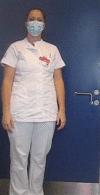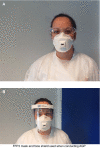Status: nosocomial transmission and prevention of SARS-CoV-2 in a Danish context
- PMID: 34050990
- PMCID: PMC8239927
- DOI: 10.1111/apm.13160
Status: nosocomial transmission and prevention of SARS-CoV-2 in a Danish context
Abstract
The unexpected pandemic with severe acute respiratory syndrome coronavirus 2 (SARS-CoV-2) has challenged the healthcare sector as regards preventing and controlling the virus from spreading between patients and hospital personnel. The massive spread of the pandemic has led state authorities to introduce restrictions on society and public behavior unprecedented in modern times. First, we describe the Danish effort regarding standard precautions, personal protective equipment, and disinfection in the healthcare setting with Denmark as an example. As regards, the number of coronavirus disease 2019 (COVID-19)-related hospital submissions, deaths, and infected healthcare workers in Denmark is not the hardest hit country compared with others. This cannot be explained by the hardness of the restrictions alone. Several aspects concerning the person-to-person spread of SARS-CoV-2 are not fully understood and require more experimental studies. The dogma is that virus transmission happens through either respiratory droplets or contact routes. However, it is likely not the whole truth, as we describe scenarios where droplets and/or direct contact cannot alone explain how all patients were infected. Aspects of the physiology of airborne transmission are considered, as several parameters are in play beyond particle size and respiratory rate. These are ozone concentration, ambient temperature, and humidity. In a hospital environment, these factors are not necessarily all controllable, making infection prevention and control a challenge.
Keywords: COVID-19; Nosocomial transmission; SARS-COV-2; airborne transmission; droplet.
© 2021 Scandinavian Societies for Medical Microbiology and Pathology.
Conflict of interest statement
None declared.
Figures
Similar articles
-
Infection Prevention Precautions for Routine Anesthesia Care During the SARS-CoV-2 Pandemic.Anesth Analg. 2020 Nov;131(5):1342-1354. doi: 10.1213/ANE.0000000000005169. Anesth Analg. 2020. PMID: 33079853 Review.
-
[Respiratory and Facial Protection: Current Perspectives in the Context of the COVID-19 Pandemic].Acta Med Port. 2020 Sep 1;33(9):583-592. doi: 10.20344/amp.14108. Epub 2020 Jun 19. Acta Med Port. 2020. PMID: 32568064 Review. Portuguese.
-
SARS-CoV-2 viability on different surfaces after gaseous ozone treatment: a preliminary evaluation.J Hosp Infect. 2021 Apr;110:33-36. doi: 10.1016/j.jhin.2021.01.014. Epub 2021 Jan 28. J Hosp Infect. 2021. PMID: 33516798 Free PMC article.
-
Infection prevention measures in acute care settings based on severe acute respiratory syndrome coronavirus 2 transmission patterns and risk: a review.Curr Opin Infect Dis. 2021 Aug 1;34(4):346-356. doi: 10.1097/QCO.0000000000000738. Curr Opin Infect Dis. 2021. PMID: 34127582
-
Investigation of nosocomial SARS-CoV-2 transmission from two patients to healthcare workers identifies close contact but not airborne transmission events.Infect Control Hosp Epidemiol. 2021 Sep;42(9):1046-1052. doi: 10.1017/ice.2020.321. Epub 2020 Jul 3. Infect Control Hosp Epidemiol. 2021. PMID: 32618530 Free PMC article.
References
Publication types
MeSH terms
Substances
LinkOut - more resources
Full Text Sources
Other Literature Sources
Medical
Research Materials
Miscellaneous




